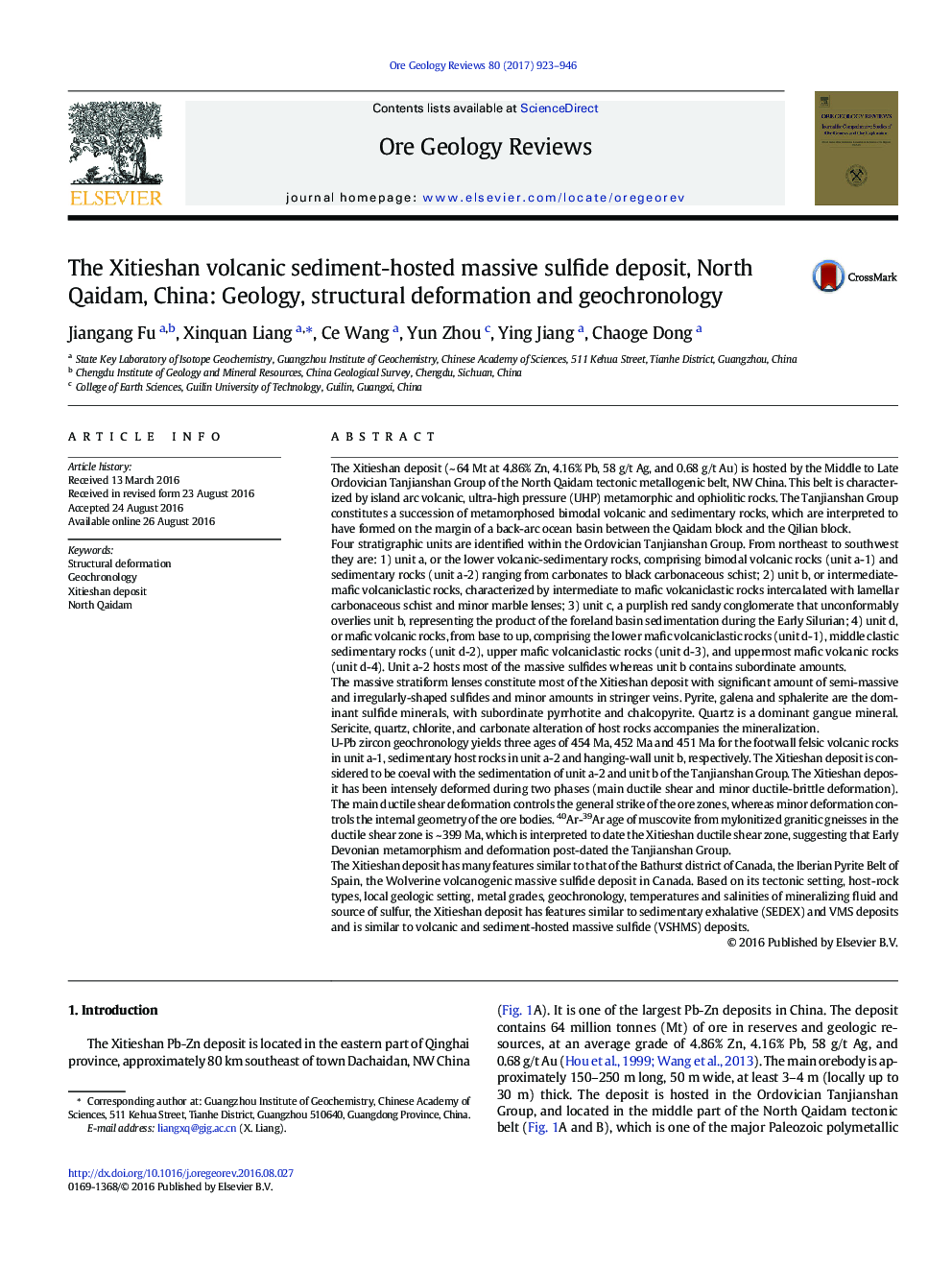| کد مقاله | کد نشریه | سال انتشار | مقاله انگلیسی | نسخه تمام متن |
|---|---|---|---|---|
| 6435671 | 1637226 | 2017 | 24 صفحه PDF | دانلود رایگان |

- A descriptive field-based geologic database of the Xitieshan deposit provided.
- Age of primary mineralization constrained at ca. 451Â Ma.
- 40Ar-39Ar age at ca. 399Â Ma.
The Xitieshan deposit (~Â 64Â Mt at 4.86% Zn, 4.16% Pb, 58Â g/t Ag, and 0.68Â g/t Au) is hosted by the Middle to Late Ordovician Tanjianshan Group of the North Qaidam tectonic metallogenic belt, NW China. This belt is characterized by island arc volcanic, ultra-high pressure (UHP) metamorphic and ophiolitic rocks. The Tanjianshan Group constitutes a succession of metamorphosed bimodal volcanic and sedimentary rocks, which are interpreted to have formed on the margin of a back-arc ocean basin between the Qaidam block and the Qilian block.Four stratigraphic units are identified within the Ordovician Tanjianshan Group. From northeast to southwest they are: 1) unit a, or the lower volcanic-sedimentary rocks, comprising bimodal volcanic rocks (unit a-1) and sedimentary rocks (unit a-2) ranging from carbonates to black carbonaceous schist; 2) unit b, or intermediate-mafic volcaniclastic rocks, characterized by intermediate to mafic volcaniclastic rocks intercalated with lamellar carbonaceous schist and minor marble lenses; 3) unit c, a purplish red sandy conglomerate that unconformably overlies unit b, representing the product of the foreland basin sedimentation during the Early Silurian; 4) unit d, or mafic volcanic rocks, from base to up, comprising the lower mafic volcaniclastic rocks (unit d-1), middle clastic sedimentary rocks (unit d-2), upper mafic volcaniclastic rocks (unit d-3), and uppermost mafic volcanic rocks (unit d-4). Unit a-2 hosts most of the massive sulfides whereas unit b contains subordinate amounts.The massive stratiform lenses constitute most of the Xitieshan deposit with significant amount of semi-massive and irregularly-shaped sulfides and minor amounts in stringer veins. Pyrite, galena and sphalerite are the dominant sulfide minerals, with subordinate pyrrhotite and chalcopyrite. Quartz is a dominant gangue mineral. Sericite, quartz, chlorite, and carbonate alteration of host rocks accompanies the mineralization.U-Pb zircon geochronology yields three ages of 454Â Ma, 452Â Ma and 451Â Ma for the footwall felsic volcanic rocks in unit a-1, sedimentary host rocks in unit a-2 and hanging-wall unit b, respectively. The Xitieshan deposit is considered to be coeval with the sedimentation of unit a-2 and unit b of the Tanjianshan Group. The Xitieshan deposit has been intensely deformed during two phases (main ductile shear and minor ductile-brittle deformation). The main ductile shear deformation controls the general strike of the ore zones, whereas minor deformation controls the internal geometry of the ore bodies. 40Ar-39Ar age of muscovite from mylonitized granitic gneisses in the ductile shear zone is ~Â 399Â Ma, which is interpreted to date the Xitieshan ductile shear zone, suggesting that Early Devonian metamorphism and deformation post-dated the Tanjianshan Group.The Xitieshan deposit has many features similar to that of the Bathurst district of Canada, the Iberian Pyrite Belt of Spain, the Wolverine volcanogenic massive sulfide deposit in Canada. Based on its tectonic setting, host-rock types, local geologic setting, metal grades, geochronology, temperatures and salinities of mineralizing fluid and source of sulfur, the Xitieshan deposit has features similar to sedimentary exhalative (SEDEX) and VMS deposits and is similar to volcanic and sediment-hosted massive sulfide (VSHMS) deposits.
Journal: Ore Geology Reviews - Volume 80, January 2017, Pages 923-946